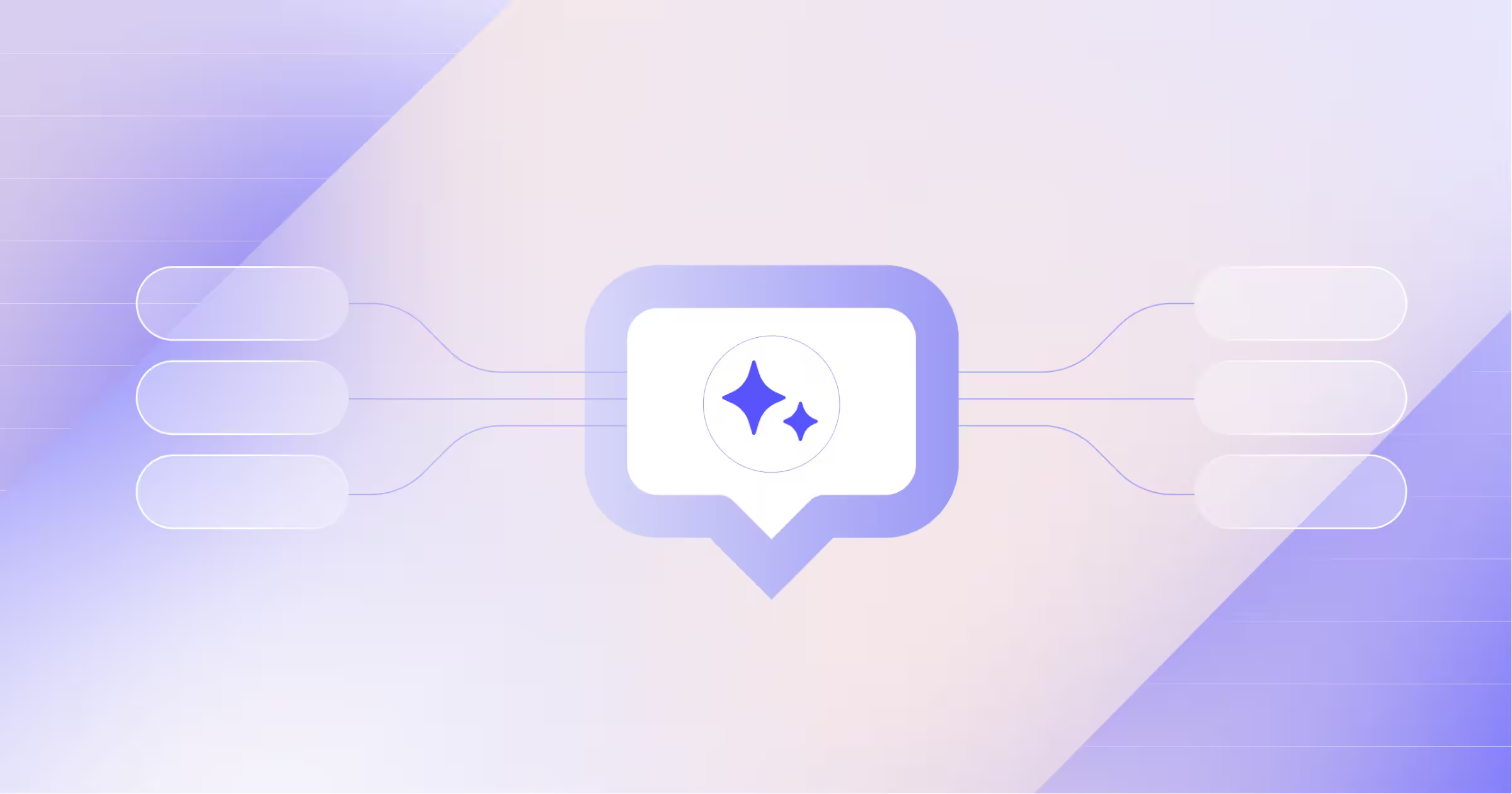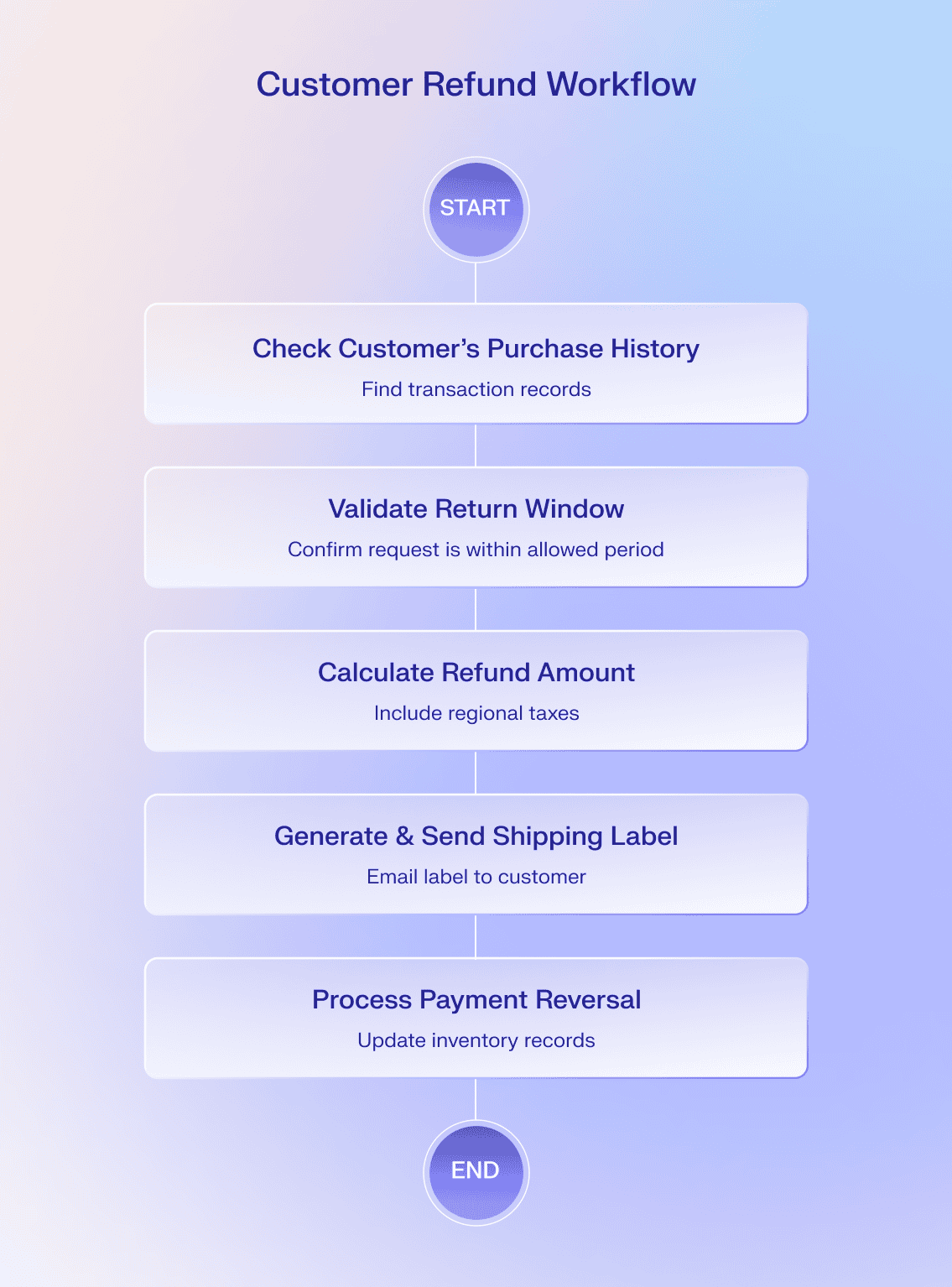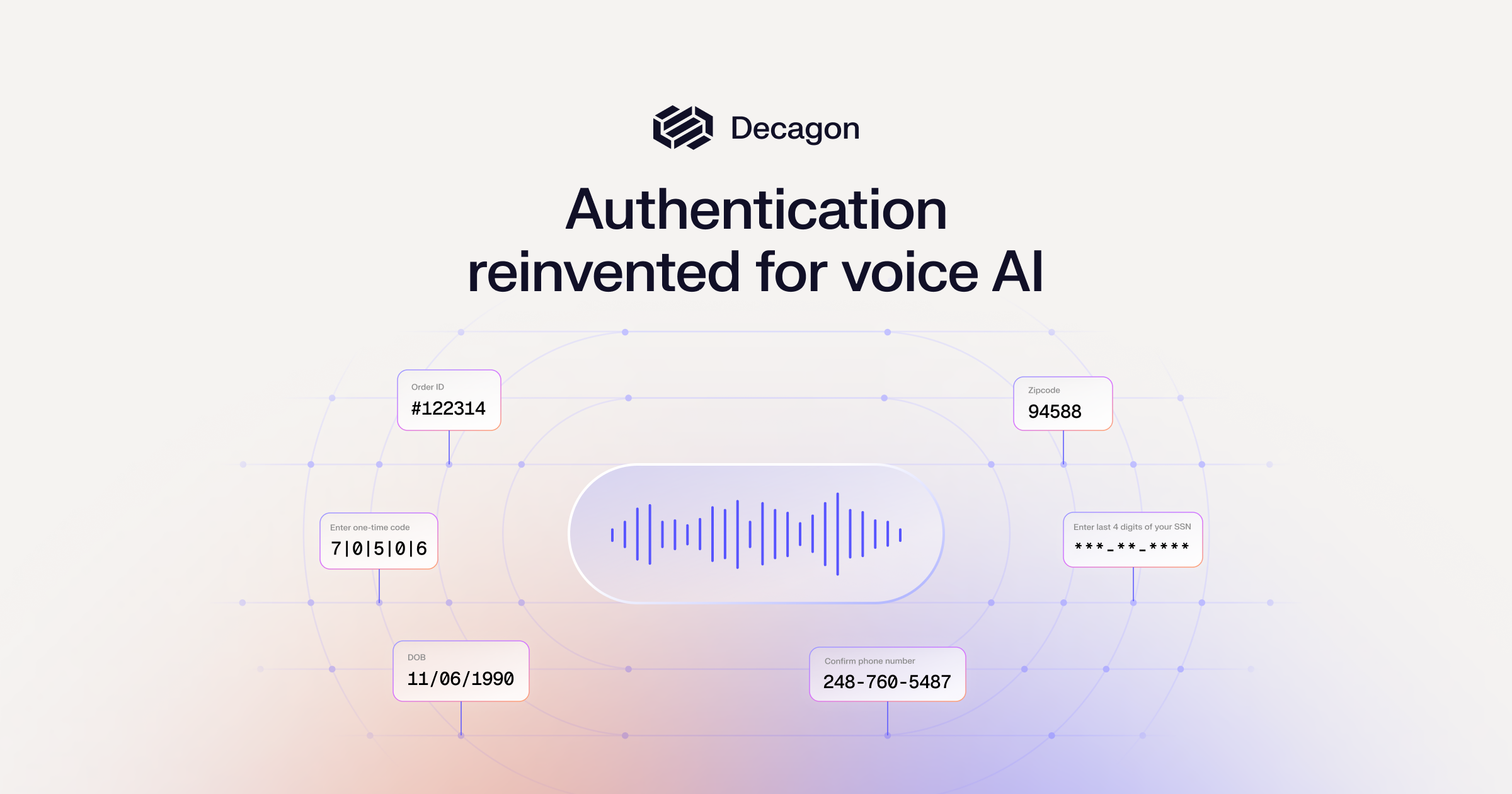What AI customer support agents actually do and how they transform support
Transform 500 daily tickets into strategic decisions. Map which support tasks AI agents should own vs humans. Real metrics, implementation timeline included.

The dual challenge of managing high ticket volumes while controlling operational costs is a constant juggling act for enterprise support. At times like these, evaluating AI solutions based on feature checklists often proves inadequate, leading to ineffective automation and poor customer experiences.
A more strategic approach is decision ownership: a framework for systematically delegating specific tasks to AI while reserving complex or sensitive issues for human agents.
True AI customer service capabilities are defined by what they can do within the boundaries you set. This means processing transactions in real-time, routing conversations based on customer emotion, and handing off issues to a human without losing context.
For instance, Notion achieved a 34% improvement in ticket resolution time by deploying AI agents for its high-volume inquiries. This level of control is enabled by tools like Agent Operating Procedures (AOPs), which use natural language rules to execute complex, secure workflows.
In this guide, we'll break down that framework, starting with the fundamental difference between a true AI agent and a traditional chatbot.
How AI agents differ from chatbots
AI agents differ from chatbots through autonomous execution of complex actions. While chatbots follow scripts to provide information, AI agents complete transactions like processing refunds, modifying subscriptions, and updating customer records through deep system integrations. AI agents use reasoning engines to dynamically plan and execute multi-step workflows independently.
For instance, a single return request can trigger an AI agent to autonomously perform an entire sequence as follows:

The ability to take decisive action, not just provide answers, is what sets a true AI agent apart.
This distinction is what separates issue deflection from true issue resolution. A chatbot might understand a request and create a support ticket, but a true AI agent can resolve the underlying issue from start to finish.
The key differences come down to four main areas:
- Primary function: A traditional chatbot's main job is to provide information, answer FAQs, and follow a pre-written script. In contrast, an AI agent is built to execute actions, complete transactions, and resolve issues on its own.
- System integration: Chatbots typically have limited connections, often just to a knowledge base or for creating a ticket. An AI agent features deep, bi-directional integration with core systems like Salesforce, Zendesk, and Stripe, allowing it to both read and write data.
- Task complexity: Chatbots handle simple, linear conversations and single-turn queries. AI agents, on the other hand, can manage complex, multi-step workflows that require dynamic planning, like processing a multi-step return.
- Decision-making: A chatbot follows a rigid decision tree or relies on keyword matching. An AI agent uses a reasoning engine to make independent decisions within the secure boundaries you set. For example, it can decide if a customer is eligible for a refund based on your business rules, not just recognize the word "refund."
This capability to take decisive, secure action is powered by a reasoning engine governed by Agent Operating Procedures (AOPs). AOPs are hybrid instruction sets that combine natural language business rules with code-level system controls, enabling AI to execute complex workflows while maintaining security boundaries.
What kinds of tasks can AI customer service agents actually handle?
AI customer service agents handle tasks across a number of different areas. Here are five example categories: identity verification (password resets, account recovery), information retrieval (order status, shipping updates), transactions (refunds, subscription changes), proactive assistance (usage tips, renewal reminders), and intelligent routing (determining the correct department or specialist).
1. Identity verification and security
This foundational category involves confirming a customer's identity to grant them secure access to their accounts and information. These tasks are ideal for customer service automation because they are process-driven, repetitive, and require strict adherence to security protocols, which an AI can follow flawlessly every time.
Common tasks include:
- Password resets: Securely guiding a user through the process of resetting a forgotten password.
- Account recovery: Assisting users who are locked out of their accounts.
- Two-factor authentication (2FA) support: Helping users set up or troubleshoot 2FA on their accounts.
- Verifying identity for sensitive actions: Asking security questions or validating information on file before making critical account changes.
2. Information retrieval and status updates
In this case, the AI agent acts as an instant, all-knowing source of information for the customer. By integrating with your CRM, order management systems, and knowledge bases, the agent can pull real-time, accurate data from multiple sources to answer customer questions instantly.
Common tasks include:
- Order status checks: Providing real-time tracking information and delivery ETAs.
- Billing inquiries: Explaining invoice charges or confirming payment dates.
- Account information: Retrieving details like subscription levels, renewal dates, or recent activity.
- Policy questions: Finding and sharing specific information from your terms of service or return policy.
3. Transactional tasks and account management
Transactional tasks are where you grant an AI agent decision ownership to directly execute actions and make changes within your core business systems. Instead of just talking about a solution, the agent is empowered to deliver it, completing tasks that would otherwise require a human agent.
This level of autonomous action is only possible with strict controls. Decagon uses Agent Operating Procedures (AOPs) to create and implement a precise rulebook for all transactional tasks, ensuring that even sensitive actions like processing payments or modifying subscriptions are performed securely and exactly according to your business rules.
Common tasks include:
- Processing refunds and returns: Initiating a refund, calculating the correct amount, and generating a return shipping label.
- Subscription management: Upgrading, downgrading, or canceling a customer's subscription plan.
- Updating account details: Changing a shipping address or updating a payment method on file.
- Appointment scheduling: Booking, rescheduling, or canceling appointments directly on a calendar.
- Applying credits or discounts: Adding a promotional code or service credit to a customer's account.
4. Proactive assistance and engagement
Proactive AI agents monitor customer accounts and usage patterns to offer timely help, improve the customer experience, and reduce the number of inbound support requests.
Common tasks include:
- Renewal reminders: Alerting customers that their subscription is about to expire and guiding them through the renewal process.
- Onboarding assistance: Sending new users helpful tips or tutorials to get them started.
- Service outage notifications: Informing affected customers about a known issue and providing status updates.
- Personalized recommendations: Suggesting products or features based on a customer's usage history.
5. Intelligent routing and triage
When an issue is too complex or emotionally sensitive for an AI agent to handle, its final and most critical job is to act as an intelligent dispatcher. The agent analyzes the customer's query, understands its intent and sentiment, and routes it to the exact right human or team to solve it. This ensures that human agents remain in the loop, receiving a pre-vetted issue with full context, allowing them to resolve it much faster.
Common tasks include:
- Department routing: Sending a billing dispute to the finance team or a technical question to engineering support.
- Sentiment-based escalation: Immediately transferring a highly frustrated customer to a specialized retention team.
- Specialist assignment: Matching a customer's specific problem (e.g., an API integration issue) with an agent who has the right technical skills.
As you can see, the level of automation for these decision types varies depending on the capabilities of your AI chatbot, your workflow's complexity, and the level of human intervention required.
⚠️ While agents can autonomously handle the vast majority of these tasks, they are critically designed to recognize emotionally-charged or highly complex situations and escalate them to human agents for empathetic and expert support.
Can AI agents integrate with Salesforce and Zendesk?
Yes, a core capability of any true AI agent is its ability to integrate deeply and bidirectionally with key business platforms, such as Salesforce and Zendesk. This connection is made possible through secure API (Application Programming Interface) endpoints, which allow the AI agent to both read customer data for context and write back updates to complete tasks.
This integration requires secure authentication (like OAuth) and specific permissions. With read-only access, an agent can retrieve information, such as a customer’s purchase history, to provide an accurate answer.
However, with API write permissions, the agent is empowered to take action. It can make authenticated API calls to create new records, update existing ones, and trigger workflows based on the conversation's outcome. This is the technical foundation that allows an agent to process a refund, not just create a ticket for one.
Platforms like Decagon are designed to integrate with all major systems. Specific capabilities include:
- For Salesforce: Accessing the full Customer 360 view, creating or updating cases with complete conversation context, and even modifying opportunity stages.
- For Zendesk: Searching the knowledge base to find answers, automatically categorizing new tickets with the correct tags and fields, and maintaining a continuous conversation history across channels.
This functionality extends beyond CRMs to include payment platforms like Stripe, e-commerce systems like Shopify, and ITSM tools like ServiceNow.
Voice capabilities: Beyond chat support
AI agents extend their capabilities to manage real-time voice conversations, offering a powerful alternative to traditional phone support. Using advanced speech recognition and natural language generation, these voice agents can understand customer requests, detect emotional tone in a caller's voice, and provide spoken responses that are remarkably clear and human-like.
Unlike rigid, traditional Interactive Voice Response (IVR) systems that force callers down a frustrating, linear path, modern voice AI can handle interruptions without losing the thread of the conversation, navigate non-linear discussions, and adjust its speaking pace to match the caller. Decagon's voice capabilities, for example, leverage advanced speech synthesis to create a natural conversation flow, complete with support for regional accents and emotion-appropriate pacing.
Voice remains a critical channel for resolving complex issues and serving key customer demographics. The business case is clear: AI voice agents eliminate frustrating hold times and provide immediate, 24/7 support while maintaining the conversational comfort that many customers prefer, seamlessly transferring to a human agent with full context when needed.
Intelligent handoffs and human-AI collaboration
The goal of AI in customer service isn't to replace human agents but to empower them. This is achieved through a seamless, collaborative model where the AI handles what it can and intelligently escalates what it cannot. AI agents are designed to trigger a handoff to a human based on specific, nuanced criteria.
An agent will initiate an escalation based on:
- Sentiment analysis: The AI detects growing frustration, anger, or distress in the customer's language.
- Query complexity: The issue exceeds the agent's pre-defined parameters or involves too many variables.
- Direct customer request: The customer explicitly asks to speak with a person.
- Repetitive loops: The customer keeps asking the same question, indicating confusion or dissatisfaction.
- High-value thresholds: The transaction is above a certain monetary value and requires human review.
Crucially, these are warm transfers, or context-preserving escalations that deliver conversation history, customer data, and resolution attempts to human agents before engagement begins.. This eliminates the dreaded "Can you please explain your problem again?"
While many platforms rely on simple keywords for escalation, advanced systems like Decagon understand the context of the situation, allowing for a far more efficient and proactive handoff.
Even after an escalation, the AI continues to support the human agent with co-pilot capabilities, such as drafting responses for review, surfacing relevant knowledge articles, and automating post-call documentation. This partnership reserves uniquely human skills, such as genuine empathy, creative problem-solving, and handling sensitive edge cases, for the situations where they matter most.
Why Decagon delivers faster ROI than alternatives
"The most trustworthy AI platforms are those that empower business experts to define outcomes while giving technical teams the controls to ensure safety. That's the formula for rapid, sustainable ROI in the enterprise." - Max Lowenthal, Director of Agent Product Management at Decagon
Decagon was built on this exact principle, delivering a faster return on investment by fundamentally changing how AI agents are created and managed. The core of this advantage lies in our Agent Operating Procedures (AOPs).
This unique, hybrid approach allows your CX and operations teams to define and modify agent workflows using natural language. Simultaneously, it gives your engineering teams the code-level controls to set firm security guardrails.
This eliminates the months-long development cycles and engineering bottlenecks common with other platforms. With AOPs, your teams can iterate and improve agent performance in days, not quarters.
This speed is supported by a robust infrastructure designed for enterprise needs:
- Multi-LLM orchestration: We use a mix of best-in-class models from OpenAI and Anthropic, selecting the right one for each specific task to optimize for speed, cost, and accuracy.
- Pre-built integrations: Our library of ready-to-use connectors for platforms like Salesforce, Zendesk, and Stripe drastically reduces setup time.
- Enterprise-grade security: With SOC 2 compliance already in place, you can deploy with confidence from day one.
The results of this approach are clear, proven by the success of our partners:
- Notion achieved 34% faster ticket resolution.
- Chime reached 70% resolution across both chat and voice channels.
- Duolingo now deflects 80% of its incoming support volume.
From 500 tickets to 3 strategic decisions
Moving beyond the daily crisis of an overflowing support queue begins with a shift in perspective.
The winners in this new era of customer service aren't those with the most advanced AI, but those who best understand which decisions to delegate to automation versus which to preserve for human expertise.
Most enterprises discover that a significant portion of their support volume involves repetitive, rules-based decisions that an AI agent can own immediately, freeing human teams to focus on complex exceptions and building customer relationships.
You can start mapping your own automation potential today:
- First, list your top 10 most common ticket types.
- Next, identify which of them follow consistent rules (think verification, information retrieval, and standard transactions).
- Finally, multiply the monthly volume by the average handle time for each to calculate your potential impact.
As you evaluate vendors, ask the critical questions: Can it execute actions or just provide information? Does it integrate deeply with your core systems? How does it handle warm, context-aware handoffs to human agents?
Then, if you're ready to move from fighting fires to building a strategic, autonomous support operation, the next step is to see this in action.
What AI customer support agents actually do and how they transform support
September 3, 2025

The dual challenge of managing high ticket volumes while controlling operational costs is a constant juggling act for enterprise support. At times like these, evaluating AI solutions based on feature checklists often proves inadequate, leading to ineffective automation and poor customer experiences.
A more strategic approach is decision ownership: a framework for systematically delegating specific tasks to AI while reserving complex or sensitive issues for human agents.
True AI customer service capabilities are defined by what they can do within the boundaries you set. This means processing transactions in real-time, routing conversations based on customer emotion, and handing off issues to a human without losing context.
For instance, Notion achieved a 34% improvement in ticket resolution time by deploying AI agents for its high-volume inquiries. This level of control is enabled by tools like Agent Operating Procedures (AOPs), which use natural language rules to execute complex, secure workflows.
In this guide, we'll break down that framework, starting with the fundamental difference between a true AI agent and a traditional chatbot.
How AI agents differ from chatbots
AI agents differ from chatbots through autonomous execution of complex actions. While chatbots follow scripts to provide information, AI agents complete transactions like processing refunds, modifying subscriptions, and updating customer records through deep system integrations. AI agents use reasoning engines to dynamically plan and execute multi-step workflows independently.
For instance, a single return request can trigger an AI agent to autonomously perform an entire sequence as follows:

The ability to take decisive action, not just provide answers, is what sets a true AI agent apart.
This distinction is what separates issue deflection from true issue resolution. A chatbot might understand a request and create a support ticket, but a true AI agent can resolve the underlying issue from start to finish.
The key differences come down to four main areas:
- Primary function: A traditional chatbot's main job is to provide information, answer FAQs, and follow a pre-written script. In contrast, an AI agent is built to execute actions, complete transactions, and resolve issues on its own.
- System integration: Chatbots typically have limited connections, often just to a knowledge base or for creating a ticket. An AI agent features deep, bi-directional integration with core systems like Salesforce, Zendesk, and Stripe, allowing it to both read and write data.
- Task complexity: Chatbots handle simple, linear conversations and single-turn queries. AI agents, on the other hand, can manage complex, multi-step workflows that require dynamic planning, like processing a multi-step return.
- Decision-making: A chatbot follows a rigid decision tree or relies on keyword matching. An AI agent uses a reasoning engine to make independent decisions within the secure boundaries you set. For example, it can decide if a customer is eligible for a refund based on your business rules, not just recognize the word "refund."
This capability to take decisive, secure action is powered by a reasoning engine governed by Agent Operating Procedures (AOPs). AOPs are hybrid instruction sets that combine natural language business rules with code-level system controls, enabling AI to execute complex workflows while maintaining security boundaries.
What kinds of tasks can AI customer service agents actually handle?
AI customer service agents handle tasks across a number of different areas. Here are five example categories: identity verification (password resets, account recovery), information retrieval (order status, shipping updates), transactions (refunds, subscription changes), proactive assistance (usage tips, renewal reminders), and intelligent routing (determining the correct department or specialist).
1. Identity verification and security
This foundational category involves confirming a customer's identity to grant them secure access to their accounts and information. These tasks are ideal for customer service automation because they are process-driven, repetitive, and require strict adherence to security protocols, which an AI can follow flawlessly every time.
Common tasks include:
- Password resets: Securely guiding a user through the process of resetting a forgotten password.
- Account recovery: Assisting users who are locked out of their accounts.
- Two-factor authentication (2FA) support: Helping users set up or troubleshoot 2FA on their accounts.
- Verifying identity for sensitive actions: Asking security questions or validating information on file before making critical account changes.
2. Information retrieval and status updates
In this case, the AI agent acts as an instant, all-knowing source of information for the customer. By integrating with your CRM, order management systems, and knowledge bases, the agent can pull real-time, accurate data from multiple sources to answer customer questions instantly.
Common tasks include:
- Order status checks: Providing real-time tracking information and delivery ETAs.
- Billing inquiries: Explaining invoice charges or confirming payment dates.
- Account information: Retrieving details like subscription levels, renewal dates, or recent activity.
- Policy questions: Finding and sharing specific information from your terms of service or return policy.
3. Transactional tasks and account management
Transactional tasks are where you grant an AI agent decision ownership to directly execute actions and make changes within your core business systems. Instead of just talking about a solution, the agent is empowered to deliver it, completing tasks that would otherwise require a human agent.
This level of autonomous action is only possible with strict controls. Decagon uses Agent Operating Procedures (AOPs) to create and implement a precise rulebook for all transactional tasks, ensuring that even sensitive actions like processing payments or modifying subscriptions are performed securely and exactly according to your business rules.
Common tasks include:
- Processing refunds and returns: Initiating a refund, calculating the correct amount, and generating a return shipping label.
- Subscription management: Upgrading, downgrading, or canceling a customer's subscription plan.
- Updating account details: Changing a shipping address or updating a payment method on file.
- Appointment scheduling: Booking, rescheduling, or canceling appointments directly on a calendar.
- Applying credits or discounts: Adding a promotional code or service credit to a customer's account.
4. Proactive assistance and engagement
Proactive AI agents monitor customer accounts and usage patterns to offer timely help, improve the customer experience, and reduce the number of inbound support requests.
Common tasks include:
- Renewal reminders: Alerting customers that their subscription is about to expire and guiding them through the renewal process.
- Onboarding assistance: Sending new users helpful tips or tutorials to get them started.
- Service outage notifications: Informing affected customers about a known issue and providing status updates.
- Personalized recommendations: Suggesting products or features based on a customer's usage history.
5. Intelligent routing and triage
When an issue is too complex or emotionally sensitive for an AI agent to handle, its final and most critical job is to act as an intelligent dispatcher. The agent analyzes the customer's query, understands its intent and sentiment, and routes it to the exact right human or team to solve it. This ensures that human agents remain in the loop, receiving a pre-vetted issue with full context, allowing them to resolve it much faster.
Common tasks include:
- Department routing: Sending a billing dispute to the finance team or a technical question to engineering support.
- Sentiment-based escalation: Immediately transferring a highly frustrated customer to a specialized retention team.
- Specialist assignment: Matching a customer's specific problem (e.g., an API integration issue) with an agent who has the right technical skills.
As you can see, the level of automation for these decision types varies depending on the capabilities of your AI chatbot, your workflow's complexity, and the level of human intervention required.
⚠️ While agents can autonomously handle the vast majority of these tasks, they are critically designed to recognize emotionally-charged or highly complex situations and escalate them to human agents for empathetic and expert support.
Can AI agents integrate with Salesforce and Zendesk?
Yes, a core capability of any true AI agent is its ability to integrate deeply and bidirectionally with key business platforms, such as Salesforce and Zendesk. This connection is made possible through secure API (Application Programming Interface) endpoints, which allow the AI agent to both read customer data for context and write back updates to complete tasks.
This integration requires secure authentication (like OAuth) and specific permissions. With read-only access, an agent can retrieve information, such as a customer’s purchase history, to provide an accurate answer.
However, with API write permissions, the agent is empowered to take action. It can make authenticated API calls to create new records, update existing ones, and trigger workflows based on the conversation's outcome. This is the technical foundation that allows an agent to process a refund, not just create a ticket for one.
Platforms like Decagon are designed to integrate with all major systems. Specific capabilities include:
- For Salesforce: Accessing the full Customer 360 view, creating or updating cases with complete conversation context, and even modifying opportunity stages.
- For Zendesk: Searching the knowledge base to find answers, automatically categorizing new tickets with the correct tags and fields, and maintaining a continuous conversation history across channels.
This functionality extends beyond CRMs to include payment platforms like Stripe, e-commerce systems like Shopify, and ITSM tools like ServiceNow.
Voice capabilities: Beyond chat support
AI agents extend their capabilities to manage real-time voice conversations, offering a powerful alternative to traditional phone support. Using advanced speech recognition and natural language generation, these voice agents can understand customer requests, detect emotional tone in a caller's voice, and provide spoken responses that are remarkably clear and human-like.
Unlike rigid, traditional Interactive Voice Response (IVR) systems that force callers down a frustrating, linear path, modern voice AI can handle interruptions without losing the thread of the conversation, navigate non-linear discussions, and adjust its speaking pace to match the caller. Decagon's voice capabilities, for example, leverage advanced speech synthesis to create a natural conversation flow, complete with support for regional accents and emotion-appropriate pacing.
Voice remains a critical channel for resolving complex issues and serving key customer demographics. The business case is clear: AI voice agents eliminate frustrating hold times and provide immediate, 24/7 support while maintaining the conversational comfort that many customers prefer, seamlessly transferring to a human agent with full context when needed.
Intelligent handoffs and human-AI collaboration
The goal of AI in customer service isn't to replace human agents but to empower them. This is achieved through a seamless, collaborative model where the AI handles what it can and intelligently escalates what it cannot. AI agents are designed to trigger a handoff to a human based on specific, nuanced criteria.
An agent will initiate an escalation based on:
- Sentiment analysis: The AI detects growing frustration, anger, or distress in the customer's language.
- Query complexity: The issue exceeds the agent's pre-defined parameters or involves too many variables.
- Direct customer request: The customer explicitly asks to speak with a person.
- Repetitive loops: The customer keeps asking the same question, indicating confusion or dissatisfaction.
- High-value thresholds: The transaction is above a certain monetary value and requires human review.
Crucially, these are warm transfers, or context-preserving escalations that deliver conversation history, customer data, and resolution attempts to human agents before engagement begins.. This eliminates the dreaded "Can you please explain your problem again?"
While many platforms rely on simple keywords for escalation, advanced systems like Decagon understand the context of the situation, allowing for a far more efficient and proactive handoff.
Even after an escalation, the AI continues to support the human agent with co-pilot capabilities, such as drafting responses for review, surfacing relevant knowledge articles, and automating post-call documentation. This partnership reserves uniquely human skills, such as genuine empathy, creative problem-solving, and handling sensitive edge cases, for the situations where they matter most.
Why Decagon delivers faster ROI than alternatives
"The most trustworthy AI platforms are those that empower business experts to define outcomes while giving technical teams the controls to ensure safety. That's the formula for rapid, sustainable ROI in the enterprise." - Max Lowenthal, Director of Agent Product Management at Decagon
Decagon was built on this exact principle, delivering a faster return on investment by fundamentally changing how AI agents are created and managed. The core of this advantage lies in our Agent Operating Procedures (AOPs).
This unique, hybrid approach allows your CX and operations teams to define and modify agent workflows using natural language. Simultaneously, it gives your engineering teams the code-level controls to set firm security guardrails.
This eliminates the months-long development cycles and engineering bottlenecks common with other platforms. With AOPs, your teams can iterate and improve agent performance in days, not quarters.
This speed is supported by a robust infrastructure designed for enterprise needs:
- Multi-LLM orchestration: We use a mix of best-in-class models from OpenAI and Anthropic, selecting the right one for each specific task to optimize for speed, cost, and accuracy.
- Pre-built integrations: Our library of ready-to-use connectors for platforms like Salesforce, Zendesk, and Stripe drastically reduces setup time.
- Enterprise-grade security: With SOC 2 compliance already in place, you can deploy with confidence from day one.
The results of this approach are clear, proven by the success of our partners:
- Notion achieved 34% faster ticket resolution.
- Chime reached 70% resolution across both chat and voice channels.
- Duolingo now deflects 80% of its incoming support volume.
From 500 tickets to 3 strategic decisions
Moving beyond the daily crisis of an overflowing support queue begins with a shift in perspective.
The winners in this new era of customer service aren't those with the most advanced AI, but those who best understand which decisions to delegate to automation versus which to preserve for human expertise.
Most enterprises discover that a significant portion of their support volume involves repetitive, rules-based decisions that an AI agent can own immediately, freeing human teams to focus on complex exceptions and building customer relationships.
You can start mapping your own automation potential today:
- First, list your top 10 most common ticket types.
- Next, identify which of them follow consistent rules (think verification, information retrieval, and standard transactions).
- Finally, multiply the monthly volume by the average handle time for each to calculate your potential impact.
As you evaluate vendors, ask the critical questions: Can it execute actions or just provide information? Does it integrate deeply with your core systems? How does it handle warm, context-aware handoffs to human agents?
Then, if you're ready to move from fighting fires to building a strategic, autonomous support operation, the next step is to see this in action.





